#susan la flesche picotte
Photo

Twelve Famous Native American Women
Native American women are traditionally held in high regard among the diverse nations, whether a given people are matrilineal or patrilineal. Traditionally, women were not only responsible for raising children and caring for the home but also planted and harvested the crops, built the homes, and engaged in trade, as well as having a voice in government.
The history of the women of the Native peoples of North America attests to their full participation in the community whether as elders and "medicine women" or as skilled agriculturalists and merchants and, in some cases, even warriors. Although hunting and warfare were traditionally the provenance of males, some women became famous for their courage and skill in battle. These women, as well as others in the arts and sciences, are often overlooked because they do not fit the paradigm of what has been accepted as American history.
Pocahontas and Sacagawea are usually the only North American Native women that non-Natives have heard of, but even their narratives have been obscured by legend and half-truths. Many other Native American women have simply been ignored, and among them are most of those listed below. These women, and the nations they were citizens of, include:
Jigonhsasee – Iroquois
Pocahontas – Powhattan
Weetamoo – Wampanoag
Glory-of-the-Morning – Ho-Chunk/Winnebago
Sacagawea – Shoshone
Old-Lady-Grieves-the-Enemy – Pawnee
Pine Leaf/Woman Chief – Crow
Lozen – Apache
Buffalo Calf Road Woman – Cheyenne
Thocmentony/Sarah Winnemucca – Paiute
Susan La Flesche Picotte – Omaha
Molly Spotted Elk/Mary Alice Nelson – Penobscot
There are many others who do not appear here because they are more widely known, such as the Yankton Dakota activist, musician, and writer, Zitkala-Sa (l. 1876-1938) or the Cheyenne warrior Mochi ("Buffalo Calf", l. c. 1841-1881). Modern-day figures are also omitted but deserve mention, such as the activist Isabella Aiukli Cornell of the Choctaw nation, who drew national attention in 2018 with her red prom dress designed to call attention to the many missing and murdered indigenous women across North America, and poet/activist Suzan Shown Harjo of the Muscogee/Southern Cheyenne nation. There are many more, like these two, who have devoted themselves to raising awareness of the challenges facing Native Americans and continue the same struggle, in various ways, as the women of the past.
Jigonhsasee (l. c. 1142 or 15th century)
According to Iroquois lore, Jigonhsasee (Jikonhsaseh, Jikonsase) was integral to the origins of the Haudenosaunee (Iroquois) Confederacy dated to either the 12th or 15th century. She was an Iroquoian whose home was along the central path used by warriors going to and from battle and became well-known for the hospitality and wise counsel she offered them. The Great Peacemaker (Deganawida) chose her to help him form the Iroquois Confederacy, based on the model of a family living together in one longhouse, and, along with Hiawatha, this vision became a reality. Jigonhsasee became known as the 'Mother of Nations' and established the policy of women choosing the chiefs of the council in the interests of peace, instead of war. The American women's suffrage movement of the 19th century called attention to the freedom and rights of Native American women, notably those of the Iroquois Confederacy, in arguing for those same rights for themselves.
Continue reading...
62 notes
·
View notes
Text
DR. SUSAN LA FLESCHE PICOTTE // PHYSICIAN
“She was a Native American doctor and reformer in the late 19th century. She became the first Indigenous woman, and one of the first Indigenous people, to earn a medical degree. She even graduated top of her medical school class. She campaigned for public health and for the formal, legal allotment of land to members of the Omaha tribe. Picotte was an active social reformer as well as physician, working to discourage drinking on the reservation where she worked. She also campaigned to prevent and treat tuberculosis, which then had no cure.”
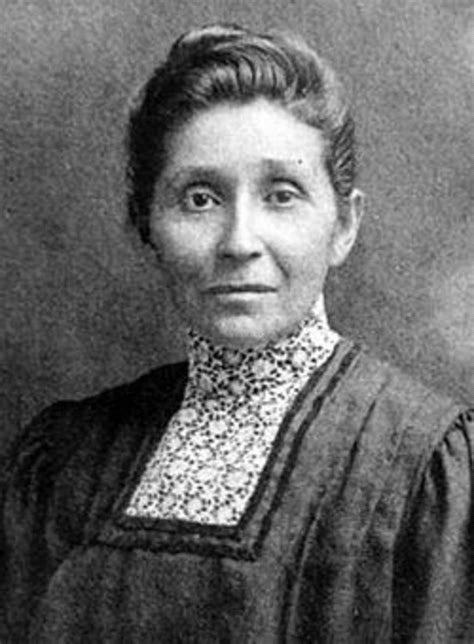

0 notes
Photo
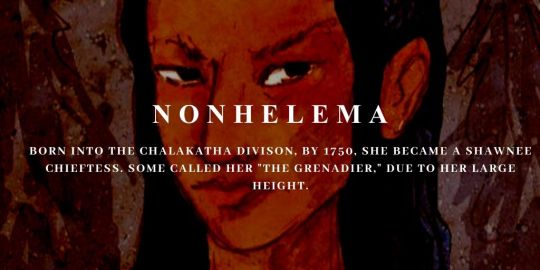








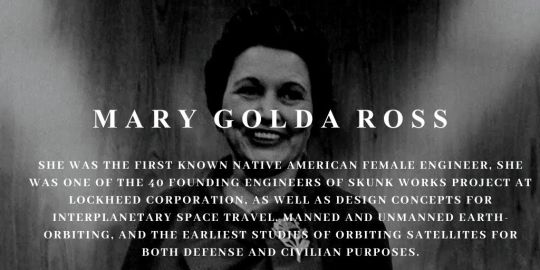
history | powerful women | north america
#history#powerful women#north america#native americans#nonhelema#woman chief#running eagle#colestah#buffalo calf road woman#moving robe woman#elizabeth wanamaker peratrovich#susan la flesche picotte#annie dodge wauneka#mary golda ross#if some of the pictures are wrong i apologize#it's super hard to find pictures of them#myedit#mine#aesthetic#graphics
3K notes
·
View notes
Photo
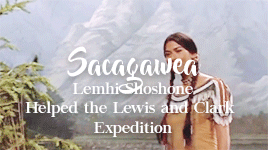


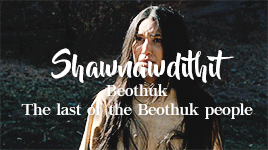
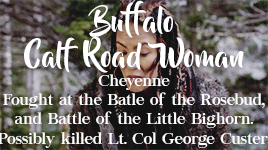

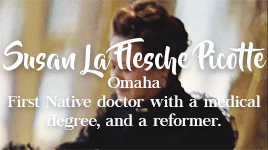
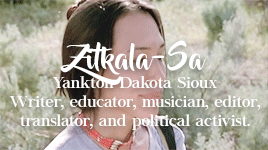
notable indigenous north american women
requested by anonymous
#historyedit#history#sacagawea#shawnawdithit#jane johnston schoolcraft#anfesia shapsnikoff#buffalo calf road woman#zitkala sa#susan la flesche picotte#19th Century#20th Century#american history#canadian history#indigenous history#native american history#native canadian history#our edits#by julia#I stuck to north american because it's too infinity if you extend it to south america#let alone all indigenous women#they can have their own separate posts
801 notes
·
View notes
Link
A good listen for Native American Heritage Month.
#This is Rachel#Native American Heritage Month#Women in STEM#BIPOC in STEM#Natives in STEM#Susan La Flesche Picotte#women in medicine#queued when i should have been writing my dissertation
1 note
·
View note
Link
#visual#Woman’s Medical College of Pennsylvania#women's history#us history#19th century#history of medicine#Anna Broomall#women in stem#Joseph S. Longshore#Drexel Archives#anandabai joshee#kei okami#Tabat M Islambooly#world history#female physicians#Halle Tanner Dillon Johnson#Sarah Mapps Douglass#Rebecca J. Cole#Omaha reservation#Susan La Flesche Picotte#photographs#women's education#history of women's education#college photos#medical school
35 notes
·
View notes
Photo
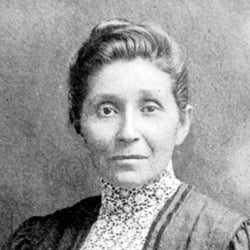
Today we remember Dr. Susan La Flesche Picotte (Omaha; June 17, 1865 – September 18, 1915), the first Native woman to become a physician in the United States, and the sole doctor for more than 1,200 people across 400+ miles.
Although she knew French and English, she refused to speak any language other than her own, Umoⁿhoⁿ. Many patients flocked to her, trusting her care because she spoke her language and knew her people.
When the Gallagher Bill to protect the inheritance of Nebraska’s Native women and children was proposed, there was much heated debate until Dr. Susan La Flesche Picotte began speaking confidently in #Umoⁿhoⁿ, winning everyone’s attention and gaining wide support for the bill.
How do you #UseYourLanguage?
190 notes
·
View notes
Text
Happy Birthday to Susan La Flesche Picotte!
In honor of Ms. LaFlesche 152nd birthday, here’s a quick biography!

LaFlesche was the first Native American to earn a medical degree in the United States in 1889, overcoming significant systemic barriers for both Native Americans and women of the time. She graduated as valedictorian of her class at the Women’s Medical College of Pennsylvania. At the time of her graduation, women were not allowed to vote, and Native Americans weren’t considered citizens of the United States.

WMCP, class of 1889. LaFlesche is second row from back, fourth from right.
Upon completing her degree, LaFlesche returned to her home reservation as a physician. So many of her constituents insisted on being treated by her that her white counterpart quit, leaving LaFlesche as the only doctor in 1,350 square miles of reservation land.
In addition to her training as a doctor, LaFlesche spoke four languages, played piano, and was very well-read. She campaigned strongly for public health measures like screen doors to keep out insects and the elimination of communal drinking cups, and resolutely fought back against the rapid spread of alcoholism in the community.
LaFlesche played many roles in the Omaha community, acting as their advocate until her death in 1915. Before she died, she managed to raise enough funds to build the reservation hospital she’d always dreamed of, the first in the county.

LaFlesche’s hospital, funded entirely by privately raised funds.
Today, LaFlesche’s heroic legacy is upheld in the continual fight for equality and good health care for Native Americans. To contribute to the cause, check out the First Nations Development Institute!
Learn more from these sources: 1 2
8 notes
·
View notes
Photo
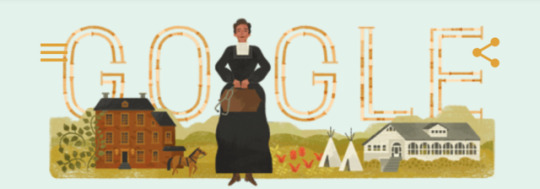
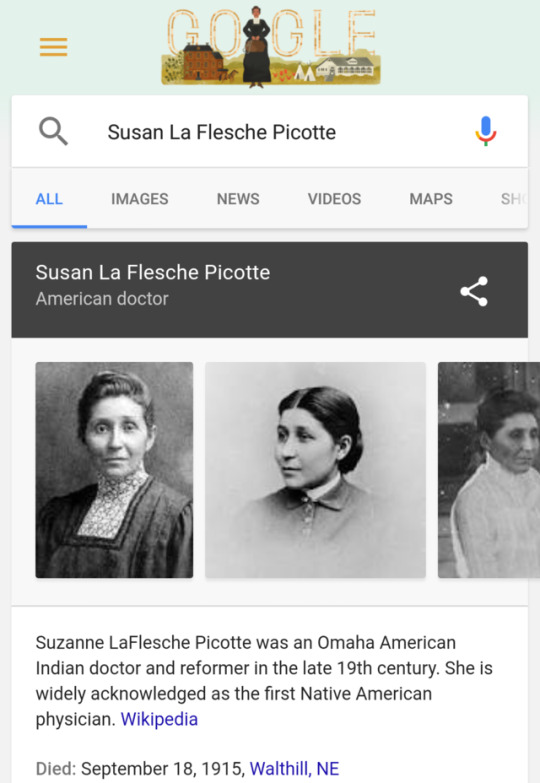
Nebraska Women in History
#susan la flesche picotte#omaha#omaha native american#women doctors#women in history#nebraska#omaha tribe of nebraska#nebraska sovereign nation
5 notes
·
View notes
Photo

Susan La Flesche Picotte // trailblazers
I’m sure we can all imagine the amount of work and time it takes to become a doctor, but imagine becoming a doctor in 1889. Now imagine that you’re also Native American and a woman. Imagine all you’d the barriers you’d have to push past, all the firsts you’d have to accomplish. Susan LaFlesche Picotte was an Omaha Indian who most consider to be not just the first Native American woman to become a doctor, but the first Native American doctor at all. After graduating first in her class at the Woman’s Medical College of Pennsylvania, she became heavily invested in social and health reform issues. She spoke widely about good health habits and returned to the reservation she was raised on to heal the sick and educate the people there about good hygiene. She fought to build a hospital on the reservation where the sick could have access to better treatment. Her most important work was her campaign against tuberculosis. The disease ran rampant among the Omaha and Picotte battled with the Office of Indian Affairs for aid which never came due to a supposed lack of funding. This didn’t stop her though. She continued to fight against this treacherous disease which killed her husband through spreading information and educating the people on how to stay safe and healthy.
1 note
·
View note
Photo


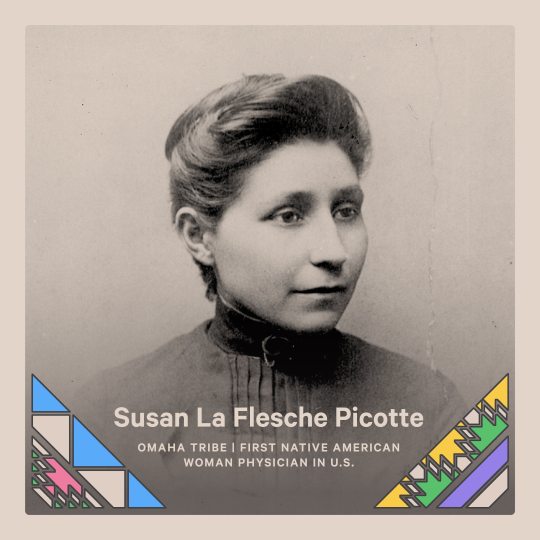
November is Native American Heritage Month: We’re celebrating by honoring a number of figures who have blazed a trail for the Native American community.
Joy Harjo is a writer, musician, & artist from the Muscogee (Creek) Nation and the current U.S. poet laureate. A central figure of the Native American literary renaissance, Harjo is known for writings that draw from tribal oral traditions and speak not only to modern-day Native experiences, but issues of feminism and social justice, as well. ‘I begin with the seed of an emotion, a place, and then move from there,’ Harjo once said of her writing process. ‘I no longer see the poem as an ending point, perhaps more the end of a journey … that can begin years earlier.’
As a child on the Omaha Reservation, Susan La Flesche Picotte witnessed an Omaha woman die after a doctor refused her treatment. That experience motivated her to pursue a career in medicine. In 1889, she became the first Native American woman in the U.S. to earn a medical degree, graduating first in her class to boot. She returned to the Omaha Reservation & set up a practice, providing sorely needed care to hundreds of residents in the area. By her 1915 death, historians estimate she had treated as many as 1,300 people over 450 sq mi. In addition to her practice, she was politically active on the reservation, defending Omaha lands from private interests & government encroachment.
A 6-time All-Star & NBA champion, Kyrie Irving is one of the most famous faces in basketball. The NBA star’s late mother was a member of the Standing Rock Sioux Tribe, and Irving was one of the most high-profile supporters of Standing Rock’s fight against the Dakota Access Pipeline throughout 2016-17. In August 2018, Irving and his sister participated in a ceremony in which they were officially welcomed home in the Standing Rock Sioux Tribe themselves. Irving received the name ‘Hela,’ which translates to ‘Little Mountain’ in Lakota.
105 notes
·
View notes
Text
Dr. Susan LaFlesche Picotte statue in Lincoln, Nebraska
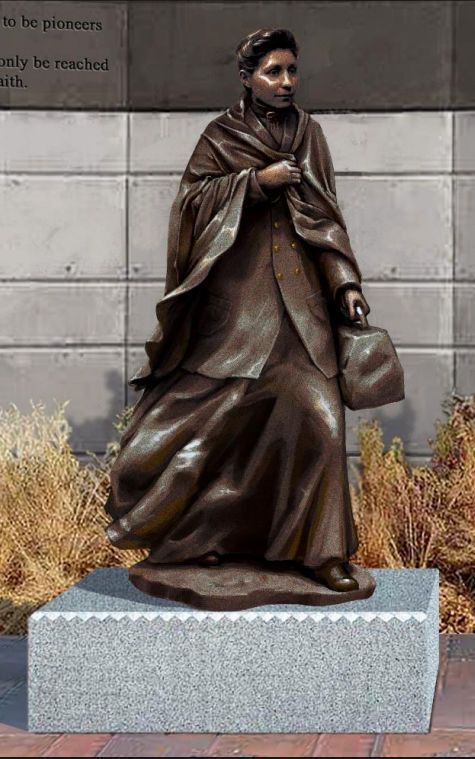
Today the state of Nebraska unveiled a statue of Dr. Susan LaFlesche Picotte. Dr. Picotte was a member of the Omaha Nation and the first Native American to earn a degree to become a medical doctor.
(article announcing statue)
(news story about unveiling today)
3 notes
·
View notes
Photo


This is a colourization I did of Dr. Susan La Flesche Picotte of Omaha Reservation, Nebraska.
She was one of the first Indigenous people to earn a medical degree in the USA. Susan was born June 17 1865 on the Omaha Reservation of Nebraska to parents Joseph La Flesche and Mary Gale. She is of Omaha-Ponca, Iowa, French, and American ancestry. Her family spoke Omaha and English in their home. She decided to become a medical Dr. after seeing a Indigenous woman die after being refused by a white Dr.. At the time it was uncommon for women to become Drs., only a few colleges offered the course to women so Susan went to Women's Medical College of Pennsylvania. After she received her medical degree she returned to her reservation to teach but ended up treating many people of the reservation. She married Henry Picotte, a Sioux man and had 2 sons with him. On the reservation she encouraged temperance, which is abstaining from alcohol as she saw alcohol as one of the biggest health concerns on the reservation. Susan spent most of her life with chronic illness and had trouble breathing at times. Before her death she suffered an injury that ultimately lead to her becoming deaf. In March 1915 she passed away of bone cancer.
I hope I did a good job at summarizing, I got most of my information from Wikipedia but there was a lot to summarize so I urge you to read the Wikipedia article on her if you want to know more: https://en.wikipedia.org/wiki/Susan_La_Flesche_Picotte
I got the original b+w picture from: https://philadelphiaencyclopedia.org/archive/womans-medical-college-of-pennsylvania/dr-picotte-2-sm/
#omaha#ponca#omaha-ponca#history#indigenous#native american#iowa#doctor#nebraska#usa#american history#pennsylvania#sioux
3 notes
·
View notes
Note
Hi! Back again with some really cool Native American women (Zitkala-Sa, Pocahontas, Susan La Flesche Picotte, Sacajawea, Molly Spotted Elk, Weetamoo, & Maria Tallchief) I'd love to see! Thank you so much for all of the women you've done! They turned out so great! I love them!
Ooh, thank you! Pocahontas, Sacagawea, and Weetamoo are coming up (just in time for Indigenous Peoples Day!)--Zitkala-Sa, Molly Spotted Elk, and Susan La Flesche Picotte might take some more time to research, however, so I can do them justice! However, I am going exclude Maria Tallchief, just because she lived so recently--I feel like RPF, however respectful, about someone whose relatives and loved ones are still around is a bit too weird for me. Sorry!)
3 notes
·
View notes
Text
Susan First Female Physician
Susan First Female Physician
Dr. Susan La Flesche Picotte, born in 1865 on the Omaha Reservation, is renowned as the “first” of many things. Not only was she the first woman of Native American ancestry to receive a medical degree in the U.S. (and among the first women in general to do so), but she is also considered the first person to receive financial aid for professional education in the U.S. Picotte was a strong…
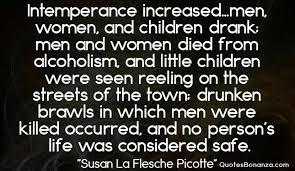
View On WordPress
1 note
·
View note
Photo

Women physicians, including Dr. Susan La Flesche (later Picotte); La Flesche is in the second row from the back, fourth woman from the right.
Courtesy Legacy Center, Drexel University College of Medicine
1889: First American Indian woman graduates from medical school
https://www.nlm.nih.gov/nativevoices/timeline/375.html
0 notes